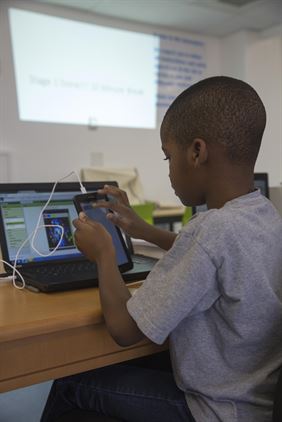
Basic Troubleshooting Steps

Overview
This activity describes basic troubleshooting steps students can take when:
- The computer doesn't turn on
- The browser window opens small
- A program they closed is still making sound
- They can no longer interact or enter on a web page
- Can't hear anything with their headphones
- Web page won't load
- The mouse isn't working
Learning Objectives
Students will:
- Be able to follow troubleshooting steps to solve common problems.
- Be able to ask the teacher or adult for help when connecting their device with an electrical outlet.
Vocabulary
- Minimize: To minimize is to make web browser window smaller.
- Maximize: To maximize is make your computer full screen.
- Restore the browser window: To restore the browser window is to use the appropriate icon to maximize a browser or program window to full screen when it is smaller.
- Refresh: To refresh is to make a browser window update to the newest view.
- Close the browser or program: To close the browser or program you use the X icon to close it.
- Taskbar or menu: A taskbar or menu is a row or set of icons on a computing device screen that are clicked on to start software applications or switch between open applications or active windows.
- Volume control: Volume controls are the software controls or icons on the computing device to increase, decrease or mute the sound.
Pre-planning
-
Be prepared to show the items identified in the vocabulary section.
-
Download and show this PowerPoint file. (After downloading the PP file, make sure the icons are lined up appropriately. Depending on your PP version, they may not be lined up appropriately anymore.)
-
Print out this Troubleshooting chart if it is helpful.
-
Here is a short video explaining all the parts of the computer. This might be helpful to show the students.
Accommodations
- See Accommodations Page and Charts on the 21things4students.net site in the Teacher Resources.
Steps
- Explain to the students that you will be talking about basic troubleshooting steps to use if they have a problem with their computer.
- Show the PPT, pausing to ask if they have ever had that problem. Ask them to explain what steps did they use to figure it out.
- Emphasize the danger and proper procedure if the problem involves plugging it into or out of a power source. Be sure to ask an adult for help. Talk about the importance of not touching cords with wet hands, or of cords that are cut or damaged.
- Explain that these are just some common problems and steps to solve them. They raise their hands and share a different problem they have had, and the steps they took to figure it out.
- Ask how many have helped or had help from another student to solve a computer problem and did it work.
- Ask how many have ever helped an adult, parent, or grandparent with a problem with technology and what they did.
Optional idea:
Create a class troubleshooting chart with steps for problems that happen. repeatedly. This can help a sub as well as themselves.
Show the Video Computer Basics: Inside a Computer if there is time.
Assessment Options
- Observations
- Check for understanding
- Do a game where you set up a computer or tablet with something wrong before they enter the room.
- Ask for a volunteer or pair that will go through troubleshooting steps to try to solve the problem.
MITECS COMPETENCIES & ISTE STANDARDS
Innovative Designer
4.a. With guidance from an educator, students ask questions, suggest solutions, test ideas to solve problems and share their learning.
4.d. Students demonstrate perseverance when working to complete a challenging task.
MITECS: Michigan adopted the "ISTE Standards for Students" called MITECS (Michigan Integrated Technology Competencies for Students) in 2018.
Devices and Resources
Device: PC, Chromebook, Mac, iPad
Browser: Chrome, Safari, Firefox, Edge, ALL
Website: Additional resources at 21things4students troubleshooting Thing and Quests.
Math
-
A step-by-step process to solve problems can be related to many math activities.
Science
-
A step-by-step process to solve problems can be related to many science activities.
Credits
This task card was created by Carolyn McCarthy, Shiawassee RESD consultant and 21things4kids Project Manager for REMC.org. Updated Sept 2022.


